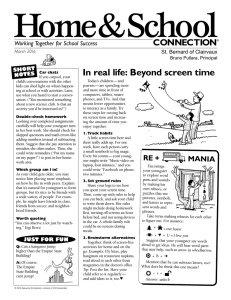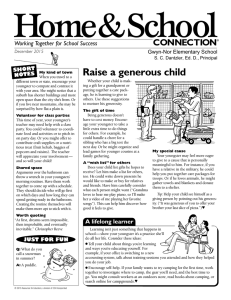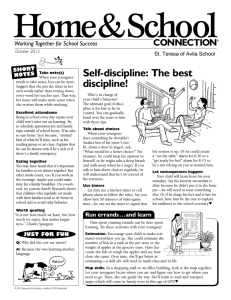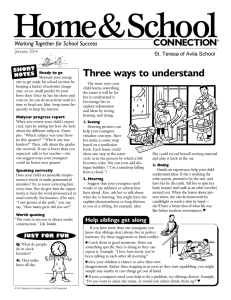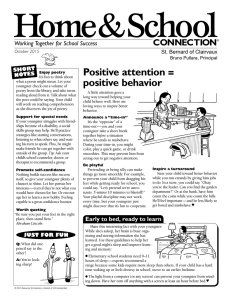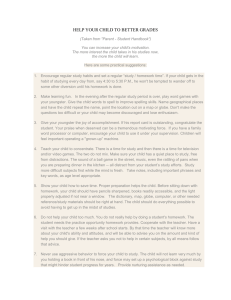Home&School Succeed with school projects CONNECTION
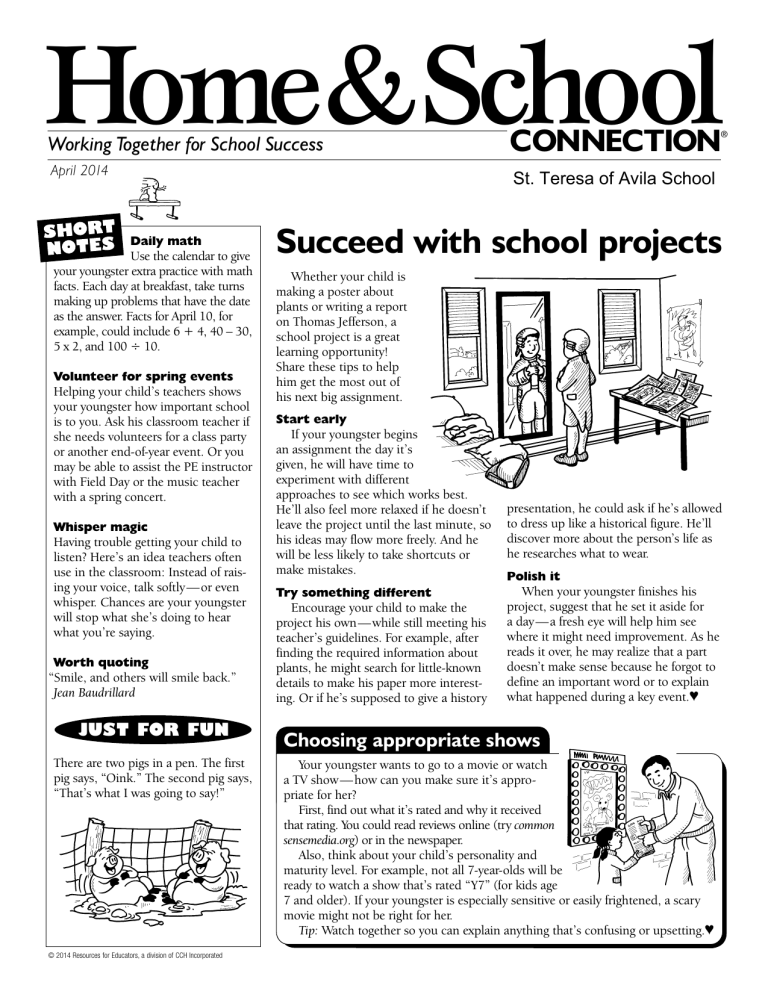
Home&School
Working Together for School Success
April 2014
CONNECTION
®
St. Teresa of Avila School
Daily math
Use the calendar to give your youngster extra practice with math facts. Each day at breakfast, take turns making up problems that have the date as the answer. Facts for April 10, for example, could include 6 + 4, 40 – 30,
5 x 2, and 100 ÷ 10.
Volunteer for spring events
Helping your child’s teachers shows your youngster how important school is to you. Ask his classroom teacher if she needs volunteers for a class party or another end-of-year event. Or you may be able to assist the PE instructor with Field Day or the music teacher with a spring concert.
Whisper magic
Having trouble getting your child to listen? Here’s an idea teachers often use in the classroom: Instead of raising your voice, talk softly — or even whisper. Chances are your youngster will stop what she’s doing to hear what you’re saying.
Worth quoting
“Smile, and others will smile back.”
Jean Baudrillard
JUST FOR FUN
There are two pigs in a pen. The first pig says, “Oink.” The second pig says,
“That’s what I was going to say!”
Succeed with school projects
Whether your child is making a poster about plants or writing a report on Thomas Jefferson, a school project is a great learning opportunity!
Share these tips to help him get the most out of his next big assignment.
Start early
If your youngster begins an assignment the day it’s given, he will have time to experiment with different approaches to see which works best.
He’ll also feel more relaxed if he doesn’t leave the project until the last minute, so his ideas may flow more freely. And he will be less likely to take shortcuts or make mistakes.
Try something different
Encourage your child to make the project his own—while still meeting his teacher’s guidelines. For example, after finding the required information about plants, he might search for little-known details to make his paper more interesting. Or if he’s supposed to give a history presentation, he could ask if he’s allowed to dress up like a historical figure. He’ll discover more about the person’s life as he researches what to wear.
Polish it
When your youngster finishes his project, suggest that he set it aside for a day—a fresh eye will help him see where it might need improvement. As he reads it over, he may realize that a part doesn’t make sense because he forgot to define an important word or to explain what happened during a key event.
♥
Choosing appropriate shows
Your youngster wants to go to a movie or watch a TV show — how can you make sure it’s appropriate for her?
First, find out what it’s rated and why it received that rating. You could read reviews online (try common sensemedia.org
) or in the newspaper.
Also, think about your child’s personality and maturity level. For example, not all 7-year-olds will be ready to watch a show that’s rated “Y7” (for kids age
7 and older). If your youngster is especially sensitive or easily frightened, a scary movie might not be right for her.
Tip: Watch together so you can explain anything that’s confusing or upsetting.
♥
© 2014 Resources for Educators, a division of CCH Incorporated
Home & School
CONNECTION
®
Nonfiction read-alouds
A nonfiction book about frogs or Antarctica makes a great bedtime story. Consider these read-aloud ideas to expose your youngster to more “real” books:
● At the library, help your youngster find nonfiction books that are in line with her tastes or reading style. For example, if she likes fictional dogs (Clifford, Biscuit), you could read aloud from a guide to different dog breeds. Or if she enjoys comic strips, she might like an illustrated encyclopedia or trivia book.
● Pair nonfiction and fiction. Try reading a story set in another country and then a nonfiction book about the
April 2014 • Page 2
customs or geography of that place. Or follow up a sports novel with a biography of a famous athlete.
● Many nonfiction books have colorful diagrams or boxes with interesting facts.
Point out features like these, and encourage your child to explore them. She’ll discover that they add information to the main text—and to her enjoyment of nonfiction.
♥
Resolving conflicts
Conflict is a normal part of life — and something your child should know how to handle so she has good relationships.
Here are two strategies.
Steps to independence
Q: My son is the same age as my sister’s son, but his cousin seems more independent. How can I help my child do more for himself?
A: Show your youngster that independence is fun.
Have him make phone calls — he might order your family’s pizza for dinner or check to see whether a store has an item he wants. Or let him stay at a safe place without you, like a friend’s birthday party or a supervised community center event.
Also, show him that it’s okay to make mistakes or to do things his own way
. If he spills milk, quietly suggest that he get a paper towel. If he loads the dishwasher differently than you do, consider letting it go. Or say, “I wonder how more dishes would fit,” and leave it to him to decide how to rearrange them.
Finally, if he says he can’t do something, ask, “What part can you do?” He might not be able to wrap a gift by himself, but he could fold up the ends or put on the tape, for instance.
♥
State the problem. Saying what’s wrong is a first step toward fixing a conflict. Perhaps your youngster is upset because her friend always picks what to play. She could tell her, “It would be more fun if we took turns deciding.”
Discuss conflicts calmly. Do family members often argue about taking the last serving of a favorite snack or borrowing each other’s video games? Bring up the issue when everyone is in a good mood, since problems are harder to solve when people are angry or tired.
Then, brainstorm solutions, and try to compromise.
♥
O U R P U R P O S E
To provide busy parents with practical ideas that promote school success, parent involvement, and more effective parenting.
Resources for Educators, a division of CCH Incorporated
128 N. Royal Avenue • Front Royal, VA 22630
540-636-4280 • rfecustomer@wolterskluwer.com
www.rfeonline.com
ISSN 1540-5621
© 2014 Resources for Educators, a division of CCH Incorporated
A homemade card game
If your youngster wants a new card game to play, suggest that he invent his own! He’ll use his imagination and practice logical thinking.
Materials: index cards, paper, pencil, crayons
3. Design the cards. Your youngster can decide how many cards to make and what to draw on each one ( examples: castle, knight, dragon; or trampoline, vault, high bar).
4. Write the rules. He should explain how to set up the game and what you do on each turn.
1. Pick a theme. Encourage him to create a game about a favorite topic, such as medieval times or gymnastics.
2. Determine the object. Maybe players win by collecting the most matching cards or earning the most points.
5. Play the game.
Follow the instructions exactly. Your child may discover that he needs to change or add steps to make the game work.
♥
